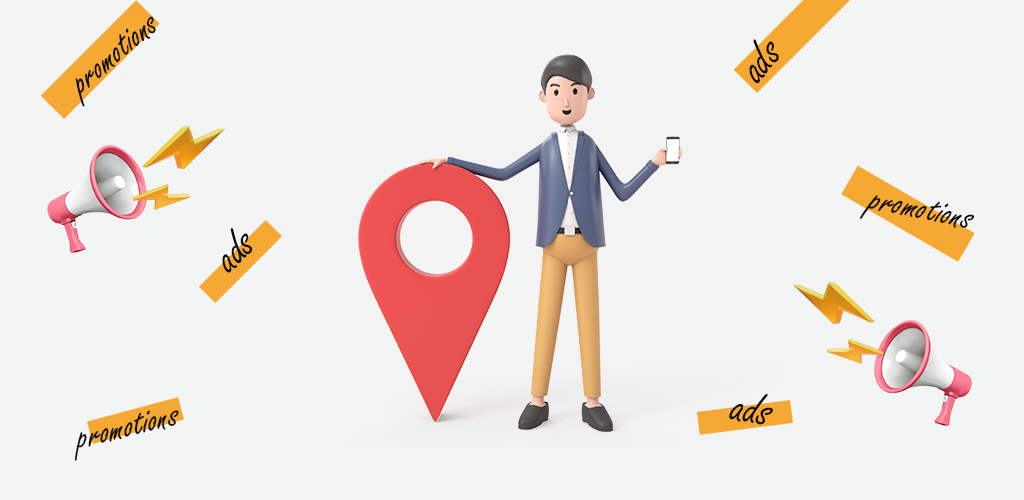Do you want to target customers who are just about to enter your competitor’s store? Or do you want to display your ads to potential customers participating in the ongoing business event? My friend, geofencing marketing is all you need to make that happen.
But what is it, exactly? And how can you use it to your advantage? In this blog post, we’ll explain everything you need to know about geofencing marketing, including what it is, how it works, and proven tips on using it effectively.
Table Of Content:
- What Is Geofencing Marketing?
- How Does Geofencing Marketing Work?
- How Companies Use Geofencing Marketing?
- Difference Between Traditional and Geofencing Marketing
- Benefits of Geofencing Marketing
- Locations to Target with Geofencing Marketing
- Geofencing Marketing Tips
- How Much Does Geofencing Marketing Cost?
- How to Track Success of Your Geofencing Marketing campaigns?
- Should You Combine SEO with Geofencing Marketing?
What Is Geofencing Marketing?
Geofencing marketing is a new way to target potential customers through their mobile devices. By creating a virtual “fence” around a specific location, businesses can send targeted ads and offers to people who are inside the fence.
For example, a retailer could use geofencing to send a notification to people’s phones when they enter the store, or a restaurant could send an offer for a discount to people near the location.
Geofencing can target any location, including schools, parks, office buildings, and even neighborhoods. The possibilities are endless.
With around 97% of Americans having a smart mobile device, geofencing marketing can be an excellent way for your business to reach potential customers.
How Does Geofencing Marketing Work?
Geofencing marketing is a new way for businesses to target potential customers. By using GPS, RFID, Wi-Fi or cellular data, companies can create a virtual “fence” around a specific location.
When someone enters the fence, they receive a notification on their phone or another device. This notification can be an ad, coupon, or even just a message from the business.
Geofencing marketing can be very effective because it allows businesses to target people already in the market for their products or service.
For example, if a business sells car parts, they could geofence a garage or car dealership. This would allow them to target people already interested in car repairs or maintenance.
Additionally, geofencing marketing can be used to target people based on their location.
For example, businesses could target people who are near their stores. This would allow businesses to reach potential customers who might be interested in buying from them.
Ultimately, geofencing marketing is a powerful tool that can be used to reach potential customers in a more targeted and efficient way.
How Companies Use Geofencing Marketing
Here are ways how marketers are using geofencing marketing:
1. Web Ads
In a geofence, customers are served ads when searching for something online.
2. Social Media Ads
Using social media platforms, companies send ads to potential customers who are in a geofence.
3. SMS Engagement
Users who have already opted in for text messages will receive companies’ SMSs when they enter a geofence.
4. Third-Party App Engagement
Third-party apps can also trigger ads when users go to a geofence area.
5. Brand Engagement
If users have installed an app from the company, they will receive push notifications whenever they are inside a geofence.
Difference Between Traditional and Geofencing Marketing
Traditional marketing involves billboards, flyers, and other activities to reach potential customers in a specific location. Geofencing marketing uses GPS and other technology to target potential customers in a particular location.
For example, a business could set up a geofence around a rival business and send special offers to people who enter the geofence.
Geofencing can also be used to target people who are near a specific location, such as a store or a landmark.
By targeting potential customers who are already in the vicinity of a business, geofencing marketing can be an effective way to boost sales.
Geofencing Vs. Geotargeting
Geofencing and geotargeting are terms that are often used interchangeably, but there is a subtle difference between the two.
Geofencing refers to creating a virtual boundary around a physical location, such as a store or a school. This boundary can be used to trigger specific actions, such as sending a notification to nearby customers or displaying relevant ads.
On the other hand, geotargeting refers to targeting individuals based on their location. This can be done using GPS data or by looking at IP addresses.
Geotargeting is often used to customize search results or provide targeted coupons.
So, while geofencing and geo-targeting involve working with location data, they are two distinct concepts.
Benefits of Geofencing Marketing
Here are key benefits of running geofence marketing campaigns:
1. Increase Brand Awareness
By setting up a virtual fence around a particular area, companies can send targeted ads and promotional materials to nearby people. Doing so can be a very effective way to increase brand awareness and reach new customers.
Moreover, geofencing marketing can also be used to track customer behavior and learn more about their preferences.
By understanding how customers interact with your brand, you can better change your marketing strategy to target them in the future.
As geofencing marketing continues to evolve, more and more businesses will likely begin to use it to increase brand awareness and reach new customers.
2. Precisely Targeted Marketing Campaigns

Geofencing marketing is a powerful tool that can help you run precisely targeted marketing campaigns.
By creating a virtual fence around a specific location, you can target ads and promotions to people who are physically present in that area. This can be particularly useful for businesses that rely on foot traffic, such as retail stores or restaurants.
Geofencing can also be used to target potential customers who are near your competitors’ locations. By running a geofenced marketing campaign, you can ensure that your message reaches the people who are most likely to respond positively to it.
3. Timely Content Delivery
Geofencing marketing is an efficient way to target potential customers with content that is timely and relevant to their interests.
After creating a virtual “fence” around a specific geographic area, you can send customized messages to nearby individuals.
This type of mobile marketing can be used to promote special offers, encourage customer loyalty, or simply raise awareness about a new product or service.
Because geofencing marketing allows businesses to target such a specific audience, it is a highly effective way to ensure that content is delivered when and where it is most likely to sway your potential customer’s minds.
4- Personalized Experiences to Your Customers
Geofencing marketing is an effective way to reach potential customers with personalized messages.
As geofencing marketing is location-based marketing, businesses can target nearby customers more likely to be interested in their products or services.
Geofencing marketing can also be used to re-engage customers who have already shown interest in your brand.
For example, if a customer visits your website but doesn’t purchase anything, you could send them geofenced push notifications with special offers and discounts the next time they’re near your store.
By personalizing the customer experience and providing relevant information at the right time, businesses can use geofencing to build relationships with customers and create loyalty.
5. Outsmart Your Competitors

With geofencing marketing, you can outsmart your competitors and take your business to the next level.
By targeting ads to people who are physically near your competitors’ locations, you can steal sales from your competitors, provided that you offer irresistible deals and discounts.
When 60% of shoppers use their mobile devices inside a store to look up product information, geofencing marketing can be a good marketing strategy to attract customers visiting your competitors’ stores.
And best of all, using geofencing marketing is relatively easy. All you need is a dedicated team of marketers who can help you target the right consumers and craft the perfect message.
6. Ability to Optimize Campaigns
At the core of geofencing marketing lies data and analytics. And you can see data in real-time.
So you have complete control over the geofencing marketing campaigns you will run for your company.
That said, you can easily optimize your campaigns to maximize their success.
Locations to Target with Geofencing Marketing
1. Your Location
By targeting your ads to clients physically near your business location, you can significantly increase the likelihood of making a sale.
2. Your Competitors’ Locations
By targeting customers at your competitors’ locations, you can reach customers who may not be aware of your business but are ready to buy.
For example, if you have a restaurant in a busy city, you can target people near your competitor’s restaurant with ads for your own business. By doing this, you can attract customers who are already interested in the type of food that you serve.
3. Relevant Events or Trade shows
By targeting relevant events or trade shows, you can ensure that your message is seen by people who are already interested in what you sell. This can help increase your marketing campaign’s effectiveness and lead to more sales.
4. Nearby Streets and Stores
By targeting customers close to your store or office, you can increase the chances that they will visit your business.
5. Crosswalks
Crosswalks are an ideal location for geofencing advertising because they are high-traffic areas with a captive audience.
By targeting crosswalks, businesses can reach a large number of potential customers with their message.
In addition, other businesses are typically located near crosswalks, which makes them ideal for promoting local deals and promotions to steal customers from your competitors.
6. Households
There are a few reasons why targeting households in a specific area is a good idea for geofencing marketing:
Quick Reach to Decision Makers
When you target households, you’re more likely to reach the decision-makers for those households. This is especially important if you’re selling a high-priced item since it’s unlikely that someone will make a significant purchase without getting input from the decision-maker.
Increased Brand Awareness Within Household
Targeting households gives you a chance to build brand awareness and loyalty within that household. If you can get people to associate your brand with positive experiences, they’re more likely to think of your brand first when they need what you offer.
Stable Customer Base
Households tend to be relatively stable, so once you’ve reached them, they’re likely to remain within your geofence for a long time. This gives you a chance to establish a long-term relationship with those customers.
7. Shopping Centers

Shopping centers are always full of people looking to buy things, which makes them the perfect place for geofencing marketing.
By targeting these areas, you can reach a large number of potential customers in a single location.
Geofencing shopping centers also allows you to target your marketing efforts more specifically, as you can focus on those who are actually in the market to purchase products or services.
Geofencing Marketing Tips
Here are some proven geofencing marketing tips for running a successful location-based marketing campaign:
1. Select Locations for Geofencing Strategically
When it comes to geofencing marketing, one of the most important things you can do is choose the correct location.
Geofencing allows you to target customers based on their location, so you must select an area that will reach your target audience.
There are a few things to consider when choosing a geofencing location, such as the population density of the area and the percentage of people who own smartphones.
You’ll also want to ensure that there are enough businesses in the area to make geofencing worthwhile.
Once you’ve selected a few potential locations, you can do A/B testing to pick the right location/s for your geofence marketing campaign.
2. Create Small Geofences
There are a few key reasons why you should create small geofences for your geofence marketing campaigns.
- Small geofences are more targeted, making you more likely to reach your target audience
- Small geofences are less likely to trigger false alarms, which can lead to potential customers being turned off by your brand
- Small geofences are easier to manage and monitor, so you can be sure that your campaigns are running smoothly.
Overall, creating small geofences is the best way to ensure that your geofence marketing efforts are successful.
3. Write Ad Copy That Wow Your Target Audience
When it comes to geofencing marketing, one of the most important things you can do is write compelling ad copy.
After all, your ad is what will persuade people to come to your location.
So, how can you ensure your ad copy is up to the task?
Here are a few tips:
Keep it Short and Sweet
Remember, potential customers are on the go when they see your ad, so they don’t have time to stop and read a novel. So, keep your ad copy concise and to the point.
Use Strong Verbs
Instead of saying ‘Come to our store,’ try something more actionable like ‘Visit our store for great deals.’ Doing so will help grab people’s attention and encourage them to take action.
Include a Call to Action
What do you want people to do after seeing your ad? Ensure your ad copy includes a call to action that tells them precisely what you want them to do.
How to Craft an Irresistible CTA
So, how can you craft an irresistible CTA for your geofencing campaign? Here are a few tips:
- Avoid long, complicated sentences – you want people to be able to read your CTA in a few seconds, not minutes
- Your CTA should be directly related to your geofencing campaign. For example, if you’re running a sale at a nearby store, your CTA could be, “Get 50% off your purchase!”
- Incorporate words that will catch attention and create a sense of urgency. Words like “sale,” “discount,” and “limited time only” are always good options
- Use an eye-catching image in your CTA. For example, if you’re promoting a sale on clothing, a picture of someone wearing a stylish outfit would be ideal
By following these tips, you can craft a CTA that is sure to capture attention and generate results for your geofencing campaign.
4. Figure out Optimal Time for Targeting

Geofencing can be a great way to target potential customers with ads, but figuring out the optimal time for your geofencing campaign can be tricky.
One way to do this is to look at historical data to see when people are most likely to be in the area you’re targeting.
Another option is to use real-time data to track when people are in your target area and adjust your marketing campaign accordingly.
You can also experiment at different times and see how your results change.
Ultimately, the best way to determine the optimal time for your geofencing marketing campaign is to test and see what works best for your business.
5. Deploy All Targeting Techniques
When it comes to targeting your audience in a geofence, you have multiple options, such as content targeting, context targeting, retargeting, social media targeting, search ads, and more.
To maximize the success of your geofencing marketing strategy, you should deploy all targeting techniques.
6. Be Transparent
While geofencing marketing can effectively reach potential customers, it can also be seen as intrusive if people don’t know they’re being targeted. That’s why it’s essential to be upfront about your geofencing campaign.
Let people know that you’re using location-based marketing and explain why you’re doing it.
For example, you might say that you’re targeting people near your store because you want them to come in and check out your latest products.
Being transparent about your geofencing campaign will help build trust with your audience and ensure they’re more receptive to your marketing messages.
7. Respect Customers’ Privacy
As a business owner, you probably already know that respecting your customers’ privacy is important.
After all, if your customers don’t trust you, they’re not likely to do business with you.
But did you know that respecting your customers’ privacy is also essential when it comes to geofencing marketing?
Geofencing marketing is a powerful tool to help you reach your target audience.
However, it can also be intrusive and invasive if you’re not careful. That’s why it’s crucial to follow privacy laws when using this marketing technique.
8. Analyze Performance and Optimize Your Campaign
Like any other digital marketing campaign, if you’re running a geofencing marketing campaign, it’s important to regularly analyze your performance and optimize your ads accordingly.
There are a few key metrics you should focus on: reach, click-through rate, conversion rate, and cost per conversion.
Monitoring these metrics will help you improve your geofencing advertising campaign.
How Much Does Geofencing Marketing Cost?
The average geofencing advertising cost ranges from $1000 to $20,000 per month, along with campaign management charges costing $150 to $1150 per month.
Like any other type of marketing, the cost of geofencing marketing will vary depending on several factors. The target market size, competition, cost per mile, and chosen marketing strategies all play a role in determining the final price tag.
However, because geofencing marketing allows business owners to target consumers with laser precision, it can be an extremely effective way to generate leads and drive sales. As a result, many companies find that the cost of geofencing marketing is more than worth it.
How to Track Success of Your Geofencing Marketing campaigns
Geofencing marketing is a powerful marketing tool that can help you reach your target users with laser precision. But how do you know if your geofencing marketing campaigns are really working?
There are a few key metrics you can track to measure success:
Ad Impressions
One metric to pay attention to is the number of impressions your ads receive. Ad impressions are the number of times your ad is shown to users within your specified geofence. You can view impression data in your campaign insights to get an idea of how many people see your ads.
Click Through Rate
Another essential metric is click-through rate (CTR). CTR measures the percentage of users who notice your ad and then click on it. A high CTR indicates that your ad is relevant and engaging and that users are taking the desired action. You can view CTR data in your campaign insights as well.
Conversions
Finally, you’ll want to track conversions to see how many people took the desired action after clicking on your ad, such as making a purchase or signing up for a newsletter.
You can track conversions in Google Analytics or another tool of your choice.
By following these key metrics, you’ll be able to gauge the success of your geofencing marketing campaigns and make necessary adjustments to improve.
Should You Combine SEO with Geofencing Marketing
If you’re trying to decide whether to combine SEO with geofencing marketing, there are a few things to consider.
First, SEO improves your website’s visibility on search results. This can be accomplished through optimizing your content, building backlinks, and local SEO.
On the other hand, geofencing marketing is a form of targeted mobile advertising that uses GPS technology to deliver ads to users based on their location.
So, geofencing marketing could be a good option if you’re hoping to reach potential customers who are close by.
However, it’s important to note that geofencing marketing can be quite expensive being a paid marketing strategy, so it might not be the best choice if you’re working with a limited budget.
Whether to combine SEO with geofencing marketing depends on your business goals and objectives.
If you’re unsure which approach is right for you, it might be worth consulting with a digital marketing agency or an experienced SEO professional.
Final Words
Geofencing is indispensable for local SEO. If you own a brick-and-mortar business, using geofencing can lead to higher footfall for customers in your store. Apart from this, geofencing can be a savior in limiting the bad clicks for paid ads.
The most crucial aspect of using this tool is knowing your target audience and setting up geofencing on the Google search console. When done right, it is a surefire way to target audiences who turn quickly into leads and ultimately into customers.


